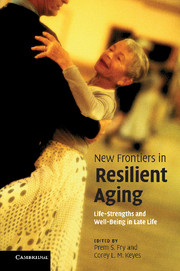Book contents
- Frontmatter
- Contents
- Figures
- Notes on contributors
- Foreword
- Acknowledgments
- Introduction
- 1 Sources of human life-strengths, resilience, and health
- 2 Growth is not just for the young: growth narratives, eudaimonic resilience, and the aging self
- 3 Physical resilience and aging:
- 4 You can teach an old dog new tricks:
- 5 Resilience in the face of cognitive aging:
- 6 Why do some people thrive while others succumb to disease and stagnation?
- 7 Psychosocial resources as predictors of resilience and healthy longevity of older widows
- 8 Resilience and longevity:
- 9 The socioemotional basis of resilience in later life
- 10 Emotional resilience and beyond:
- 11 Risk, resilience, and life-course fit:
- 12 Resilience in mobility in the context of chronic disease and aging:
- 13 Positive aging:
- Index
- References
7 - Psychosocial resources as predictors of resilience and healthy longevity of older widows
Published online by Cambridge University Press: 06 December 2010
- Frontmatter
- Contents
- Figures
- Notes on contributors
- Foreword
- Acknowledgments
- Introduction
- 1 Sources of human life-strengths, resilience, and health
- 2 Growth is not just for the young: growth narratives, eudaimonic resilience, and the aging self
- 3 Physical resilience and aging:
- 4 You can teach an old dog new tricks:
- 5 Resilience in the face of cognitive aging:
- 6 Why do some people thrive while others succumb to disease and stagnation?
- 7 Psychosocial resources as predictors of resilience and healthy longevity of older widows
- 8 Resilience and longevity:
- 9 The socioemotional basis of resilience in later life
- 10 Emotional resilience and beyond:
- 11 Risk, resilience, and life-course fit:
- 12 Resilience in mobility in the context of chronic disease and aging:
- 13 Positive aging:
- Index
- References
Summary
Abstract
Many factors affect the observed increase of mortality following loss of a spouse. In the research reported in this chapter, we focus on the influence of recently recognized psychosocial resource factors in enhancing the resilience and healthy longevity of older widows. We conducted a 6.5-year longitudinal study of the mortality risk of 385 older widows, who were assessed at baseline on measures of perceived psychosocial resources, health-related self-reports, and psychological traits of challenge and control. A Cox regression analysis of predictor variables was used to examine the mortality risk related to the baseline measures of psychosocial resources and psychological trait measures. Those widows who survived longer were mainly those with higher scores on spiritual resources, and on resources of family stability, social engagement, and commitment to life tasks. In contrast, high scores on control and challenge traits had an unexpected negative effect on longevity. Our findings confirm that psychosocial resource factors have a significant effect on resilience and longevity.
Introduction
A broad range of factors can influence the mortality of women who have become widows. In the research reported in this chapter, we examine the extent to which key psychosocial resources influence the resilience and healthy longevity of older widows.
Widowhood is a common occurrence in the lives of midlife and older women. Almost one half of women over the age of 65 years are widowed (Fields and Casper, 2001). The gerontological literature (e.g.
- Type
- Chapter
- Information
- New Frontiers in Resilient AgingLife-Strengths and Well-Being in Late Life, pp. 185 - 212Publisher: Cambridge University PressPrint publication year: 2010
References
- 3
- Cited by



